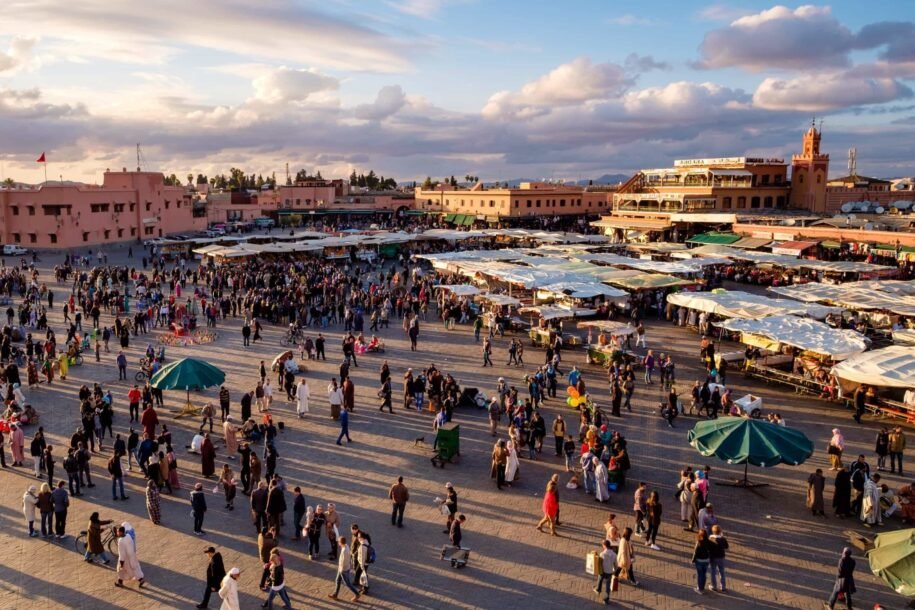Jemaa El-Fna is more than just a square; it is the soul of Marrakech. This iconic public space, located in the heart of the city, has been a gathering point for centuries. Recognized as a UNESCO World Heritage Site in 1985 and listed as part of the Intangible Cultural Heritage of Humanity in 2008, Jemaa El-Fna remains a vibrant center of culture, history, and entertainment. Whether you are visiting during the day or night, the square offers an unforgettable experience, blending Moroccan traditions, stories, and lively activities.
The Historical Significance of Jemaa El-Fna Square
Jemaa El-Fna is steeped in history, dating back to its creation by the Almoravid dynasty in 1071. Initially known as Rahba El Ksar, or “The Palace Square,” it was constructed near a royal palace. Over the centuries, its name evolved to Jemaa El-Fna, which translates to “Assembly of the Dead.” This name has sparked many legends, each contributing to the square’s mysterious charm.
One story links the name to the devastating plague that struck Marrakech between 1598 and 1607, claiming countless lives. Another legend ties it to Sultan Ahmed Al-Mansour, who passed away during the epidemic. He planned to build a grand mosque called Jemaa El Hana, but the project never materialized. Finally, historical accounts describe Jemaa El-Fna as a place of public justice during the 12th to 14th centuries, where executions were carried out in front of crowds.
Despite its somber origins, the square transitioned into a lively hub of commerce and entertainment by the 16th century. It became known as a cosmopolitan space where traders, performers, and storytellers gathered. Today, Jemaa El-Fna stands as a testament to the city’s resilience and cultural richness.
Where Is Jemaa El-Fna Located?
Jemaa El-Fna sits at the entrance of Marrakech’s old city, the Medina, and is situated southwest of the bustling souks. It is also close to the famous Koutoubia Mosque, an architectural marvel built in the 12th century. This prime location makes Jemaa El-Fna a central meeting point for locals and tourists alike.
The square’s triangular layout leads visitors toward various attractions, from traditional markets to historic landmarks. Whether you wish to explore the labyrinth of souks or relax in a nearby café, Jemaa El-Fna is the perfect starting point for your Marrakech tour.
What Makes Jemaa El-Fna So Unique?
Jemaa El-Fna is often described as an open-air theater, with its dynamic atmosphere drawing visitors from around the world. It is a place where culture and tradition come alive through music, dance, and storytelling. From sunrise to late at night, the square is brimming with activities that cater to every interest.
During the day, you will encounter snake charmers, fortune tellers, and henna artists offering their unique services. Traditional water sellers, dressed in vibrant costumes, roam the square, carrying leather water bags and brass cups. Musicians and performers create a lively soundtrack, blending ancient tunes with modern rhythms.
As the sun sets, Jemaa El-Fna transforms into an even more magical space. Food stalls light up, filling the air with the aroma of Moroccan spices and freshly grilled delicacies. Street performers, including acrobats and fire-eaters, captivate audiences with their skills. Storytellers and poets gather small crowds, sharing tales that have been passed down through generations.
A Culinary Paradise
One of the highlights of Jemaa El-Fna is its diverse culinary offerings. The food stalls serve a variety of dishes, from traditional Moroccan tajines and couscous to more adventurous options like snail soup. Freshly squeezed orange juice is a popular choice, providing a refreshing break from the heat.
Visitors can also enjoy sweet treats such as chebakia (honey-coated pastries) and almond-filled dates. For those seeking a more formal dining experience, the square is surrounded by cafés and rooftop restaurants offering stunning views of the bustling crowds below. Whether you are a foodie or simply curious, Jemaa El-Fna’s culinary scene is not to be missed.
Shopping and Souvenirs
Jemaa El-Fna is a shopper’s paradise, offering an array of goods that reflect Morocco’s rich craftsmanship. From leather goods and traditional carpets to spices and handmade jewelry, the square is a treasure trove of unique items. Bargaining is a common practice, so do not hesitate to negotiate for the best price.
The nearby souks are an extension of the square’s vibrant shopping scene. These markets are organized into sections based on the type of goods sold, making it easy to find everything from pottery to textiles. Whether you are searching for a memorable souvenir or a gift, the shops around Jemaa El-Fna have something for everyone.
Practical Tips for Visitors
While Jemaa El-Fna is a safe place to explore, it is important to remain cautious. Scammers and overly persistent vendors may try to overcharge tourists. Always agree on prices before accepting services, such as henna tattoos or photographs with performers. Negotiating is part of the culture, so approach it with a friendly attitude.
If you plan to visit the square at night, keep an eye on your belongings, as it can get crowded. Comfortable shoes and light, breathable clothing are essential for navigating the square, especially during the warmer months.
FAQ About Jemaa El-Fna
What is the best time to visit Jemaa El-Fna?
The square is lively throughout the day, but the atmosphere is most enchanting in the evening. This is when food stalls open, and the performances reach their peak.
How much time should I spend at Jemaa El-Fna?
You can spend anywhere from a couple of hours to an entire day exploring the square and its surrounding attractions. It depends on your interests and schedule.
Is Jemaa El-Fna family-friendly?
Yes, the square offers activities for all ages. Children will enjoy the street performances and the chance to interact with animals like monkeys and camels.
Are there any guided tours of Jemaa El-Fna?
Morocco Dream Safari offer guided visits to Jemaa El-Fna, providing insights into its history and cultural significance. Our Marrakech tours often include stops at the nearby souks and historical sites.
What should I wear when visiting Jemaa El-Fna?
Modest clothing is recommended, especially for women. Lightweight, breathable fabrics are ideal for the warm climate. Comfortable footwear is a must for walking around the square.
Why Visit Jemaa El-Fna Square?
Jemaa El-Fna is not just a tourist destination; it is an experience that immerses you in the essence of Morocco. From its historical roots to its vibrant modern-day activities, the square captures the spirit of Marrakech like no other place. Whether you are savoring local delicacies, shopping for handmade treasures, or enjoying the lively performances, Jemaa El-Fna promises memories that will last a lifetime.
So, when you find yourself in Marrakech, make sure to visit Jemaa El-Fna. It is a place where the past and present coexist, offering a glimpse into the heart of Moroccan culture.


Leave a Reply